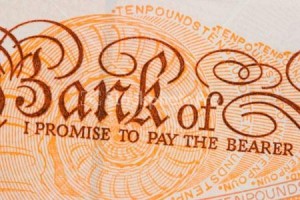 Dear Mr Bailey,
Dear Mr Bailey,
I have in my possession a 'banknote' with your name on it, but am unclear as to its meaning. The words "I promise to pay the bearer on demand the sum of five pounds" are followed by the image of your signature, which makes me think it is a contract between you, the signatory, and me, the current bearer. So I write in hope that you might clarify a few questions which arise in me.
1) Which of the following types of legal instrument is this banknote? A promissory note of some 'pounds' from you to me? A bill, which unlike most bills I have used, carries the signature of the debtor rather than the creditor? A contract between you the signatory and me the bearer?
2) I understand that the 'pound', a unit of weight, used to refer to sterling silver, but I don't know what it refers to now. Can you tell me precisely what kind of things the 'five pounds' are that you will 'pay' me, and why I might be desirous of them?
3a) If this banknote is a contract, does that mean it is governed under Statute Law? 3b) If I, as a party to the contract, don't understand the contract, which I clearly do not, does that not invalidate the contract? 3c) In my experience a contract is only valid when signed by hand on the actual paper. What exceptions exist in law that your printed signature is acceptable on a contract and mine is not?
4) I have heard that destroying money is illegal. Does that mean that the bearer of the banknote is not the owner of it?
5) I understand that your organisation was implemented in the LIBOR scandal. To what extent must I the bearer 'trust' you the signatory?
6) At what times and places are you available for me to 'demand' these five pounds? Would I be required to attend you in person to be paid or can the transaction take place online somehow?
7) What enforcement lies behind the bill? I mean what would happen to the bank if, when I demanded these pounds, you failed to deliver?
8) Some advantage must accrue to those who can issue money without first having to earn it. But there must be heavy responsibilities that accompany that privilege. Who ensures that you honour these responsibilities?
9) I hope I'm not getting confused with US law, but I suspect they are similar. I understand that all people are equal under the law and that under the law companies such as the B of E, are 'persons'. How would I go about issuing legal tender?
10) I notice that other central banks issue similar 'banknotes'. The United States bills claim to be 'legal tender', and promise nothing to the bearer, while the European Central Bank bills have nothing at all to say for themselves; they merely carry a signature free of context. Do these pieces of paper mean something different to your banknotes?
I find it hard to imagine how the economy functions when the money itself is so mysterious. I hope you will be able to offer simple direct answers to my simple direct questions. Matthew Slater


Comments4
Member for
17 years 9 monthsThe bank replies: Thank you
The bank replies:
Thank you for your e-mail of 15 April address to Mr Bailey concerning banknotes. Your e-mail has been passed to me to reply on Mr Baileys’ behalf.
In order to provide you with as complete an answer as possible, I do not intend to answer your questions point by point as some stray from your main focus on Bank of England banknotes.
When Mr Bailey occupied the position of Chief Cashier his signature automatically appeared on our banknotes in line with tradition. However, this does not infer any contract etc between Mr Bailey and the holder of a banknote. Mr Bailey’s signature appeared there to represent the Bank of England being the signature of the Chief Cashier.
The words 'I promise to pay the bearer on demand the sum of....' which continue to appear on our banknotes, date from the days when our banknotes were backed by gold, and meant that the Bank of England undertook to exchange any banknotes paid in by the public with gold to the same value. This is no longer the case, however, and these days our banknotes are backed by securities. 'I promise to pay the bearer..' holds true today including in respect of
1) Any out of date (ie withdrawn) Bank of England notes, and
2) Current defaced, torn or in any other sense 'mutilated' Bank of England notes
When we pay out against such notes, we nowadays simply exchange them for new (i.e. replacement) notes. You may wish to be aware that the legislation governing the above is the Currency and Banknotes Act 1954, Chapter 12.
Legally Bank of England notes are promissory notes for the purposes of the Bills of Exchange Act 1882. Section 83(1) of the Act provides that a 'promissory note is an unconditional promise in writing made by one person to another signed by the maker, engaging to pay, on demand or at a fixed or determinable future time, a sum certain in money, to, or to the order of, a specified person or to bearer.'
Section 1(4) of the Currency and Bank Notes Act 1954 Act provides that the "holder of [Bank of England] bank notes of any denominations shall be entitled, on a demand made by him during office hours at the head office of the Bank of England or, in the case of notes payable also at some place other than the head office, either at the head office or at that other place, to receive in exchange for the notes bank notes of such lower denominations, being bank notes which for the time being are legal tender in the United Kingdom or in England and Wales, as he may specify." This preserves the legal form of the banknote, but the promise to pay does not have the same meaning as it did three hundred years ago.
Bank notes may be exchanged at the Bank of England Head Office in London. If visiting in person, our opening hours are Monday to Friday, 9.00am – 3.00pm (excluding bank holidays).
Other legislation relevant to notes and currency include the Bank Charter Act 1844, the Currency and Bank Notes Acts 1928 and 1954. These Acts provide for the establishment of a distinct Department within the Bank of England - the Issue Department - for the issue of banknotes. They also require notes issued by the Bank to be backed by securities held in the Issue Department and confer legal tender status on Bank of England notes. No other banknotes carry legal tender status in the UK and it would require further legislation to change these arrangements.
With respect to the history of the name pound and the pounds sign, the pound sign (‘£’) is the symbol for pound sterling, the currency of the United Kingdom and for some currencies of the same name in other countries.
You may be interested to know that the use of this symbol as a unit of currency goes back many years. The origin of the pound sign itself developed over the years from the letter L, the initial letter of the Latin word 'Libra', meaning a pound of money. It is not actually known for certain when the horizontal line, or lines – which indicate a contraction – first came to be drawn through the L, although there is, in the Bank's collection, a cheque dated January 1660 with a clearly discernible ‘£’ sign. By the time that the Bank of England was founded in 1694, the ‘£’ symbol was in common use.
Two publications on the subject that may assist you are:
The Pound, A Biography
Sterling: The Rise and Fall of a Currency
Finally, I am afraid that I cannot comment on the status of US Dollar or Euro banknotes, you will have to write to the appropriate authorities.
Thank you once again for writing to the Bank. I hope that I have been able to clarify these matters for you.
This reminds me of a question
This reminds me of a question that I have concerning central bank operations. The function of reserves ... for fiat currencies.
Of course it is comprehensible that the term dates from when there were ostensible gold &/or other reserves backing money. But to retain the term reserves for something backing un-backed currency, and to add lunacy to obfuscation, the reserves are fiat reserves or promises to pay fiat, appears rather odd. Pythonesque, even. Of course, they are really there to hide something else, but that's another story.
co money today is fiat money
co money today is fiat money , it has no real value. , from 1816 till 1920 approx 4 ounces of .925 silver. Was £1 sterling. From 1920 to 1947. All uk silver coins were. Now debased to 50 % silver , , so £1 sterling now was 2 ounces of pre 1947 uk silver coins. After 1947. U.K. Used cupo nickel. And not silver , the gold sovereign worth 20 shillings was last used as legal tender in 1931. Reason it was withdrawn. In 1931. One sovereign was worth £1 and 9d just for the gold value. , it would be great. If every the uk purchased. We paid in silver bullion , and when we sold anything we were paid in gold bullion.
What I think is being said
What I think is being said here is this, our UK money notes are backed by nothing more than a histrionic "hope" , moreover , that this extrapolating pantomime might continue. But one ought not be surprised if living under a benign dictatorship?